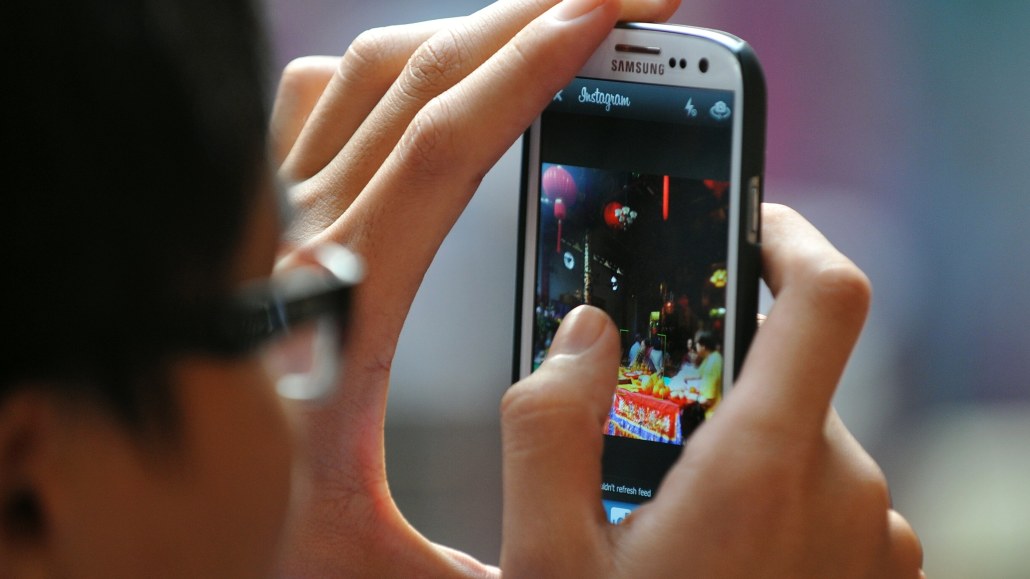Save 50% on a 3-month Digiday+ membership. Ends Dec 5.

Get ready for promoted Instagram hashtags and accounts, as well as brands you don’t follow popping up in your feed.
Last week, Instagram’s director of business operations Emily White told The Wall Street Journal that the popular photo and video sharing platform will roll out an ad model within the year. With Instagram’s large user-base — it just recently reached 150 million monthly active users — brands are both curious and optimistic about Instagram’s ad potential.
Building an ad system is more than just “turning on the revenue spigot.” Tech platforms that have ad models need to do more than just put come-ons in front of users. They have to do so from scratch, running the risk of turning off users. There are the unsexy but important things like targeting, analytics and support.
“Brands have embraced Instagram since its inception,” said Katrina Craigwell, head of digital marketing at GE. “Similar to the introduction of ad products on Tumblr this year, Instagram ads would help solve the challenge of audience building on the platform, allowing content strategists to tackle production and distribution strategies with a bit more ease and justify increased investment overall.”
But as GE and other marketers have noted, the most important thing for Instagram and brands to keep in mind will be to make sure that the ads create the least amount of disruption possible to the user experience and flow of content on Instagram. For example, just using Instagram’s video function to post 15-second spots would not be ideal. Luckily brands are creating some pretty compelling posts that can be turned into ads. For example, Burberry has over 940,000 followers and has posted plenty of ad-worthy fashion images and cool videos.
The advantage Instagram has, of course, is it is owned by Facebook, which is now a major advertising force. White herself jumped over to Instagram from Facebook, and prior to that she worked at Google. So it’s not like Instagram is some naive startup going into media donning rose-colored glasses.
As a platform, Instagram can follow an off-the-shelf playbook, perfected by Facebook, Twitter and others. The first challenge: Get brands using the platform. It’s done this: 67 percent of the world’s top brands are on Instagram, according to Simply Measured. Next, platform ad models need to solve a problem for brands operating for free on their platform. This is usually around offering brands visibility. For a brand like GE, many of its posts might not be seen by all its followers. Platforms typically also help with gaining brands even more followers. GE has 143,832 followers on Instagram and his been on the platform since 2011.
As far as what Instagram’s ad model could actually look like, there are plenty of possibilities. Instagram could offer promoted accounts to follow and promoted hashtags, like Twitter does. There could be video ads in Instagram feeds, promoted content in the “Explore” section of Instagram. No matter what, bet on the ads being “native.” Banners aren’t coming.
“The best Instagram ads will look identical to highly engaging Instagram posts from brands right now,” said Matt Britton, founder and CEO of MRY. “The only difference is the user will begin to see these posts from brands they have yet to follow.”
That’s all well and good, but even if Instagram nails the user experience and brand benefit it has to also provide the back-end tools that make ads more effective and show advertisers what’s working. That means targeting and analytics. Like anything involving data, this is easier said than done.
“What I’m really interested in is whether or not Instagram will be able to target certain consumers and create contextual relevance based on the very limited data that you have to input into Instagram to set up,” said Aubrey Flynn, brand content director for Ciroc Vodka. “But if they can leverage Facebook data, that would work.”
While perhaps a logical solution, connecting Instagram profiles to Facebook is no small task, Britton added. Between the different usernames on each platform, different privacy settings, different code and just the sheer volume of user data between the two platforms, synching becomes complicated.
Also at issue is the ability to drive clicks. As Drew Neisser, CEO of social agency Renegade, pointed out, as of now you can’t include hyperlinks in any copy that goes with Instagram photos or videos.
“Without a means of driving clicks somewhere, Instagram will only be able to sell impressions – and cheap ones at that,” said Neisser.
Another challenge for Instagram is the fact that there are already a lot of brands are on the platform that are already seeing great success with it. These companies are, Neisser said, getting thousands of consumers to see their posts “without paying a dime.”
The safe money is on Instagram and Facebook to figure this out. It is growing fast, still has its cool factor, and is popular with brands — and brand managers alike.
“Facebook is not a company in need of cash and they will handle the implementation of an advertising strategy on Instagram very delicately,” said GE’s Britton. “This will be a product that is highly in demand.”
Image via Shutterstock
More in Media

European publishers say the Digital Omnibus ‘cookie fix’ leaves them worse off
The European Union’s attempt at a legislative spring clean for Europe’s web of data privacy rules, has landed flat with publishers.

Digiday+ Research Subscription Index 2025: Subscription strategies from Bloomberg, The New York Times, Vox and others
Digiday’s third annual Subscription Index examines and measures publishers’ subscription strategies to identify common approaches and key tactics among Bloomberg, The New York Times, Vox and others.

From lawsuits to lobbying: How publishers are fighting AI
We may be closing out 2025, but publishers aren’t retreating from the battle of AI search — some are escalating it, and they expect the fight to stretch deep into 2026.





